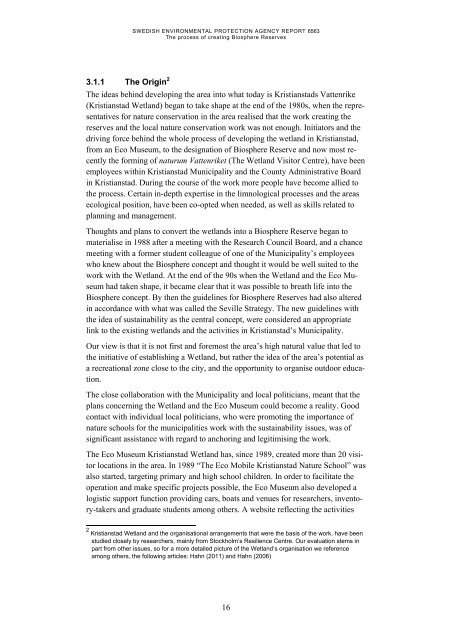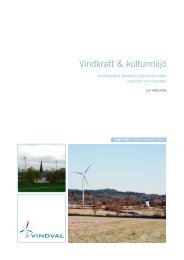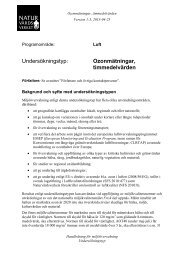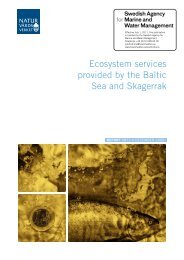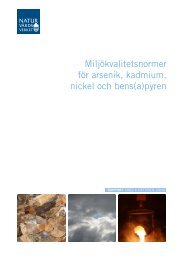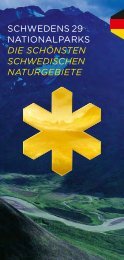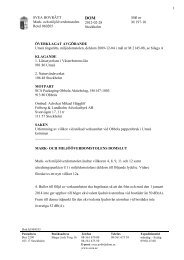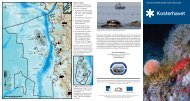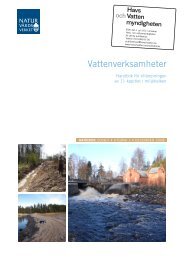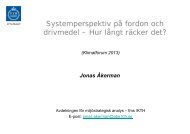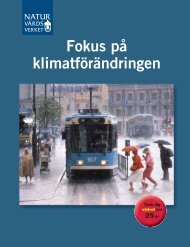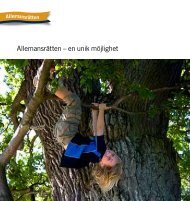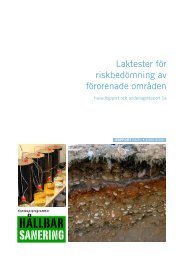The process of creating Biosphere Reserves- An ... - Naturvårdsverket
The process of creating Biosphere Reserves- An ... - Naturvårdsverket
The process of creating Biosphere Reserves- An ... - Naturvårdsverket
You also want an ePaper? Increase the reach of your titles
YUMPU automatically turns print PDFs into web optimized ePapers that Google loves.
SWEDISH ENVIRONMENTAL PROTECTION AGENCY REPORT 6563<br />
<strong>The</strong> <strong>process</strong> <strong>of</strong> <strong>creating</strong> <strong>Biosphere</strong> <strong>Reserves</strong><br />
3.1.1 <strong>The</strong> Origin 2<br />
<strong>The</strong> ideas behind developing the area into what today is Kristianstads Vattenrike<br />
(Kristianstad Wetland) began to take shape at the end <strong>of</strong> the 1980s, when the representatives<br />
for nature conservation in the area realised that the work <strong>creating</strong> the<br />
reserves and the local nature conservation work was not enough. Initiators and the<br />
driving force behind the whole <strong>process</strong> <strong>of</strong> developing the wetland in Kristianstad,<br />
from an Eco Museum, to the designation <strong>of</strong> <strong>Biosphere</strong> Reserve and now most recently<br />
the forming <strong>of</strong> naturum Vattenriket (<strong>The</strong> Wetland Visitor Centre), have been<br />
employees within Kristianstad Municipality and the County Administrative Board<br />
in Kristianstad. During the course <strong>of</strong> the work more people have become allied to<br />
the <strong>process</strong>. Certain in-depth expertise in the limnological <strong>process</strong>es and the areas<br />
ecological position, have been co-opted when needed, as well as skills related to<br />
planning and management.<br />
Thoughts and plans to convert the wetlands into a <strong>Biosphere</strong> Reserve began to<br />
materialise in 1988 after a meeting with the Research Council Board, and a chance<br />
meeting with a former student colleague <strong>of</strong> one <strong>of</strong> the Municipality’s employees<br />
who knew about the <strong>Biosphere</strong> concept and thought it would be well suited to the<br />
work with the Wetland. At the end <strong>of</strong> the 90s when the Wetland and the Eco Museum<br />
had taken shape, it became clear that it was possible to breath life into the<br />
<strong>Biosphere</strong> concept. By then the guidelines for <strong>Biosphere</strong> <strong>Reserves</strong> had also altered<br />
in accordance with what was called the Seville Strategy. <strong>The</strong> new guidelines with<br />
the idea <strong>of</strong> sustainability as the central concept, were considered an appropriate<br />
link to the existing wetlands and the activities in Kristianstad’s Municipality.<br />
Our view is that it is not first and foremost the area’s high natural value that led to<br />
the initiative <strong>of</strong> establishing a Wetland, but rather the idea <strong>of</strong> the area’s potential as<br />
a recreational zone close to the city, and the opportunity to organise outdoor education.<br />
<strong>The</strong> close collaboration with the Municipality and local politicians, meant that the<br />
plans concerning the Wetland and the Eco Museum could become a reality. Good<br />
contact with individual local politicians, who were promoting the importance <strong>of</strong><br />
nature schools for the municipalities work with the sustainability issues, was <strong>of</strong><br />
significant assistance with regard to anchoring and legitimising the work.<br />
<strong>The</strong> Eco Museum Kristianstad Wetland has, since 1989, created more than 20 visitor<br />
locations in the area. In 1989 “<strong>The</strong> Eco Mobile Kristianstad Nature School” was<br />
also started, targeting primary and high school children. In order to facilitate the<br />
operation and make specific projects possible, the Eco Museum also developed a<br />
logistic support function providing cars, boats and venues for researchers, inventory-takers<br />
and graduate students among others. A website reflecting the activities<br />
2 Kristianstad Wetland and the organisational arrangements that were the basis <strong>of</strong> the work, have been<br />
studied closely by researchers, mainly from Stockholm’s Resilience Centre. Our evaluation stems in<br />
part from other issues, so for a more detailed picture <strong>of</strong> the Wetland’s organisation we reference<br />
among others, the following articles: Hahn (2011) and Hahn (2006)<br />
16


